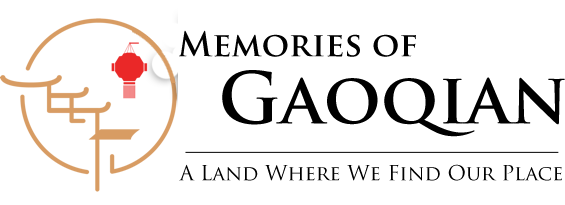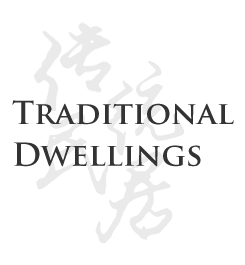The existing houses in Gaoqian Village were built during the Ming and Qing Dynasties, and are unique in that they are of the Huizhou style, while also incorporating the styles of the mountainous buildings of eastern Zhejiang. These dwellings integrate practicality and aesthetic value well: the houses are mainly built with white walls and black tiles, with a simple and clean color scheme that is in keeping with the smoky and rainy climate of the south of the Yangtze River; they face south with their backs to the north at 15 degrees southeast, which is conducive to ventilation and light, and can be adapted to the needs of temperature regulation in different seasons; the exterior is shaped like a horsehead wall, which can not only hide from sight and protect privacy, but also act as a barrier in the event of a fire. The patio in the courtyard allows residents to be exposed to the outdoors without having to leave their homes, bringing people closer to nature and accelerating ventilation, regulating indoor temperature and providing a safe space in which older people and children can move around. The houses are connected by corridors sheltered by eves, which can shade from the sun and rain and facilitate people's activities in different weather conditions
Gaoqian Village now has 26 ancient houses, a one-li-long commercial street, 2 ancient ancestral halls, 15 ancient wells and 1 ancient temple. The 11 representative well-preserved ancient houses in the village, one next to the other from east to west, are about 500 meters long, with a grand layout that has survived for hundreds of years. The architectural style of each is roughly the same. All the buildings are two-storied, but the internal space is flexible and varied with differences in similarity. The large scale enclosed courtyards makes it possible for multiple generations to share the same house or to be neighbors, thus shaping harmonious, friendly and supportive relationships.
Qiganli (South) is one of the better- preserved houses in Gaoqian village. It is named after the flagpole stone in front of the gate. There are three existing courtyards. On the central axis are the foyer, the front courtyard, the central hall, the middle courtyard, the principal hall, and the backyard, with two-storied Xiangfang (chamber) on the left and right of the front yard. The two-storied main hall is the width of three rooms with a floor area of more than 2,400 square metres. One of the flagpole stones in front of the door was destroyed by lightning, and the other two were used as water-powered pestles to pound rice during the Cultural Revolution. According to the research of Wu Ruzhi and the accounts of some older residents, Qiganli (South) was built by Wu Shuzhi (1802-1848), the 31st generation of the Wu family. Outside the main gate of Qiganli (South), the words on Men E 门额(the upper part of the lintel of the door)read “Pingfeng Songcui屏峰耸翠”. Pingfeng refers to Cuiping Mountain in the south. Men E is a characteristic feature of Gaoqian dwellings and is commonly found on the outer walls, on the lintels above the main gates and side doors of the dwellings, consisting mainly of verses about the natural world, describing the sentiments that lingering in the landscape and fields evoke, demonstrating the interests and elegant taste of the those who owned and live in these houses. The east and west gates of the backyard of Qiganli (south) are marked, respectively, with the words 'Greenery surrounded by water' and 'Mountains bring greenery'.
The Chengzhu(承祖) Hall, is the largest residential building in Gaoqian in terms of its floor area of more than 3,500 square metres. ‘Chengzhu’ means to inherit the grace, wealth and discipline of the ancestors. The Hall was built in the Qing Dynasty, comprising three mansions and nine halls. The remaining three courtyards include a foyer, a main hall, a front yard, a main hall and a back yard on the central axis. The front and back yards are flanked by two-storey Xiangfang on the left and right, while the two-storey main hall is two rooms wide. The original building was destroyed in the fire in the early years of the Republic of China, and the existing building was built by the Wu family in the Shui Men School水门派 around 1920. The present building is in a poor state of preservation, with some of the eave columns damaged.
Wood carving, stone carving and brick carving are some of the distinctive decorative features of the houses in Gaoqian. Wood carvings are mainly used to decorate building components and furniture, from large wooden pillars, arches, Niqiu beams泥鳅梁(loach) and Niutuidonggua beams牛腿冬瓜梁(the beams look like bull leg and wax gourd), to small components such as doors and windows, from Niutui牛腿, to Queti雀替as well as daily necessities such as beds, tables, chairs, and stationery. Wood carvings present a wide range of subjects, including figures, flowers and plants, landscapes, insects and fish, birds and animals, poems and various auspicious motifs. Depending on the needs of the architectural elements, engraving, relief carving and hollow carving techniques are used.
Stone carvings are featured on the stone pillars of ancestral halls, theatres, memorial archways, bridges and Men E, door frames, as well as on the well fences, flower platforms, windows, pillar bases, stone lions and so on of residential buildings. The content is mostly symbolic, with auspicious clouds, dragons and phoenixes, cranes, lions, elephants, unicorns, and the eight treasures. Bogu博古(pictures carved on utensils etc.), also use symbols of auspiciousness as well as landscape scenery, figures and stories, etc., mainly employing engraving, relief, and hollow carving techniques, that are simple and vigorous, natural and vibrant. Brick carving is a decorative feature comprising exquisite carving on the locally produced grey blue bricks of Xianju, widely seen in the doorways, lintels, door frames, eaves, rooves and roof-tiling of these residential buildings and giving them a look that is both vivid and elegant. The bricks are carved in flat, relief or 3-D, and the subjects include animals such as dragons, tigers, lions, elephants, rabbits and deer, landscapes, flowers and birds, opera stories and historical figures and sometimes powerfully evokes folk features and customs. These surviving carvings in Gaoqian, not only demonstrate the superb craftsmanship of ancient China, but also preserve aspects of its rich cultural symbolism and bear witness to its key aspirations and values such as peace and good fortune, longevity, and the blessing of many children. They speak of how people in the past understood their culture and pursued their life goals in ways that are no longer familiar today.

